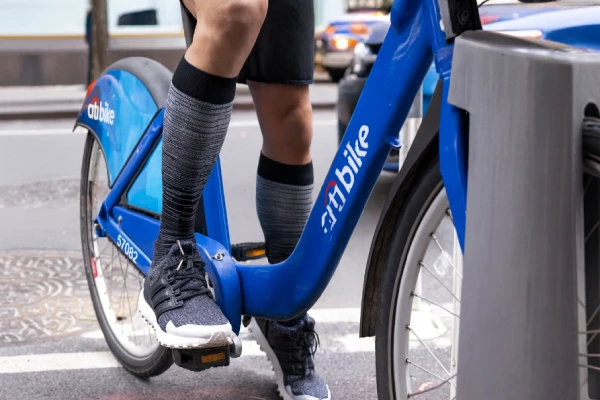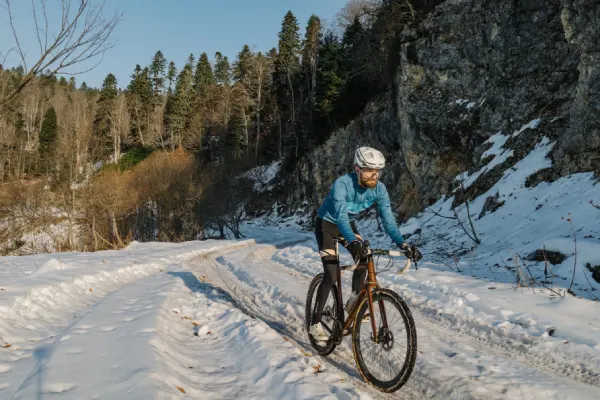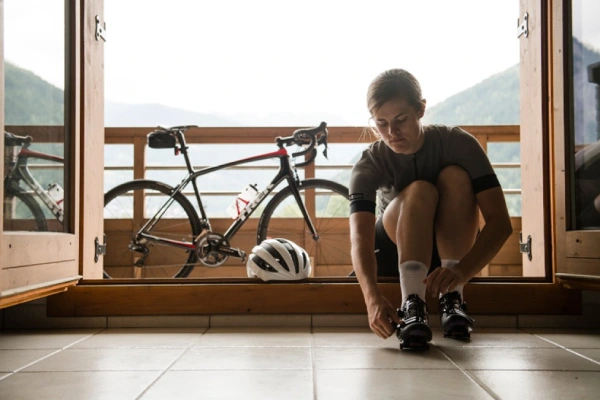Intro
Cycling socks aren’t just another piece of gear — they’re a performance tool that can make or break your ride. While many cyclists choose socks based on usage type (road, mountain, commuting, triathlon), functional differences can have an even greater impact on comfort, efficiency, and endurance.
In this guide, we’ll explore four essential functional categories of cycling socks — compression, anti-slip, quick-dry, and thermal — and explain how each serves a distinct purpose. Whether you’re climbing steep trails, racing on the tarmac, or pedaling through freezing winter mornings, the right functional choice can help you ride longer, recover faster, and stay comfortable in any condition.
We’ll also connect these functions to materials, seasonal variations, and riding scenarios, so you can build a sock rotation that keeps you performing at your peak all year round.
Pro Tip: If you haven’t yet read our Cycling Socks by Use guide, start there to understand how usage type and function work together for optimal results.
Compression Cycling Socks
Purpose & Performance Benefits

Compression cycling socks are engineered to improve blood circulation, reduce muscle vibration, and accelerate recovery during and after rides. They apply graduated pressure — tighter at the ankle and looser towards the calf — which helps push oxygen-rich blood back to your muscles and flush out lactic acid more efficiently.
For endurance cyclists and long-distance riders, this can mean less fatigue, fewer cramps, and better post-ride recovery. Competitive racers also use them as part of their race-day kit to maintain performance in high-intensity stages.
Ideal Riders & Scenarios
- Endurance riders who log 80–200 km in a single ride.
- Stage racers managing multiple days of high-intensity effort.
- Commuters who want reduced swelling in legs and ankles after daily rides.
- Recovery sessions when worn post-ride to help speed up muscle repair.
Technical Features to Look For
- Graduated compression zones — effective pressure mapping from ankle to calf.
- Arch and ankle support — stabilizes the foot during repetitive pedal motion.
- Moisture-wicking materials — to avoid heat buildup during long rides.
- Seamless construction — prevents hotspots and blisters.
Material Considerations
While most compression socks use nylon-spandex blends for elasticity and durability, you’ll find performance variations:
- Nylon + Spandex → best for consistent compression and durability.
- Polyester blends → lighter, more breathable for summer use.
- Merino wool blends → compression plus warmth for winter riding.
Anti-Slip Cycling Socks
Purpose & Performance Benefits

Anti-slip cycling socks are designed to keep your feet locked in place, preventing unwanted movement inside your cycling shoes. This ensures a more stable pedal stroke, improves power transfer, and significantly reduces the risk of blisters caused by friction.
They’re especially valuable for high-intensity rides or technical terrains where foot stability is critical — think aggressive mountain biking, sprint finishes, or cyclocross races in muddy conditions.
Ideal Riders & Scenarios
- Mountain bikers tackling rocky descents and rapid cornering.
- Sprinters who need every watt transferred into the pedals.
- Gravel riders facing mixed terrain and unpredictable grip.
- Commuters who want extra stability in all-weather conditions.
Technical Features to Look For
- Silicone grip zones on the sole, heel, or inside the cuff.
- Textured or ribbed weaves for in-shoe traction.
- Reinforced heel & toe for added durability.
- Moisture control to prevent sweat-induced slippage.
Material Considerations
Anti-slip designs usually use nylon or polyester blends for durability, paired with elastic fibers for stretch. Some premium options integrate woven grip yarns or coated fibers to enhance traction without bulk.
Recommended Brands for Anti-Slip Cycling Socks
- GripGrab Race Aero – Ultra-light with silicone print sole grips; great for road and TT racing.
- Swiftwick Aspire Zero – Known for tight, performance fit and slip-free feel even during sprints.
- Assos GT Socks C2 – Premium build with lightly textured sole for improved in-shoe hold.
Quick-Dry Cycling Socks
Purpose & Performance Benefits

Quick-dry cycling socks are built to wick moisture away from the skin, speeding up evaporation to keep feet dry and comfortable. This is crucial for preventing blisters, reducing odor-causing bacteria, and maintaining optimal comfort during hot-weather rides or multi-discipline events like triathlons.
In high humidity or intense heat, sweat accumulation can soften the skin and increase friction. Quick-dry fabrics help maintain foot integrity, keeping performance consistent from start to finish.
Ideal Riders & Scenarios
- Summer road cyclists riding in 25°C+ temperatures.
- Triathletes transitioning from swim to bike to run.
- Gravel riders in wet or humid environments.
- Indoor training where sweat rates are high.
Technical Features to Look For
- High-performance synthetic fibers like polyester or nylon blends for moisture transfer.
- Mesh ventilation panels for airflow.
- Lightweight, low-bulk construction to speed drying.
- Seamless toe design to reduce friction points when wet.
Material Considerations
Quick-dry designs almost always rely on synthetic performance fabrics for maximum evaporation speed. Blends may also include:
- Polypropylene – hydrophobic, repels water while wicking sweat.
- Coolmax® – specialized polyester for moisture control.
- Elastane – for stretch without absorbing moisture.
Recommended Brands for Quick-Dry Cycling Socks
- Castelli Superleggera T 18 – Ultra-lightweight, high ventilation for scorching summer rides.
- Specialized Hydrogen Aero – Combines fast-drying fibers with aerodynamic ribbing.
- Pearl Izumi Elite Tall – Mesh ventilation zones and moisture-wicking polyester for long, hot rides.
Pro Insights
Quick-dry socks are perfect for triathlons since they minimize the discomfort of wet-to-dry transitions, but they also shine on long summer climbs where overheating can be a serious performance risk.
For more on pairing quick-dry socks with the right fabrics, see our Materials in Cycling Socks guide.
Thermal Cycling Socks

Purpose & Performance Benefits
Thermal cycling socks are designed to retain heat, protect feet from wind chill, and keep circulation flowing during cold-weather rides. In low temperatures, feet are often the first to lose warmth, which can impact comfort, pedal efficiency, and even safety.
These socks create a layer of insulation that traps body heat without sacrificing breathability, ensuring that sweat is managed while warmth is maintained.
Ideal Riders & Scenarios
- Winter commuters cycling in near-freezing conditions.
- Alpine riders tackling high-altitude climbs.
- Cyclists training at dawn or in late evening when temperatures drop.
- Adventure touring riders who face unpredictable weather.
Technical Features to Look For
- Merino wool or thermal blends for natural warmth and moisture regulation.
- Thicker knit zones in the toe and heel for insulation.
- Wind-resistant weaves or double-layer cuffs.
- Longer cuff height to overlap with leg warmers or tights.
Material Considerations
The best thermal cycling socks often combine:
- Merino wool – naturally warm, odor-resistant, and breathable.
- Acrylic fibers – for added softness and thermal retention.
- Nylon or polyamide – for durability and shape retention.
Recommended Brands for Thermal Cycling Socks
- Rapha Winter Socks – Premium merino blend, extra-tall cuff for deep winter rides.
- GripGrab Merino Winter Socks – Thermal weave with reinforced sole for cold-weather durability.
- DeFeet Woolie Boolie – Classic merino wool warmth with robust construction for daily winter use.
Cycling Socks by Function — Comparison
| Function Type | Main Purpose | Ideal Conditions / Riders | Key Features | Recommended Brands |
|---|---|---|---|---|
| Compression | Improve circulation, reduce fatigue, aid recovery | Endurance riders, stage racers, long-distance commuters | Graduated zones; arch support; moisture-wicking; seamless build | Castelli Free Aero Race 15; CEP Ultralight; Rapha Pro Team |
| Anti-Slip | Prevent foot movement; enhance power transfer; reduce blisters | MTB, sprinters, gravel riders | Silicone grips; textured weaves; reinforced heel/toe; moisture control | GripGrab Race Aero; Swiftwick Aspire Zero; Assos GT C2 |
| Quick-Dry | Keep feet dry; prevent odor & blisters; improve comfort | Summer rides, triathlon, humid climates, indoor training | Poly/nylon blends; mesh ventilation; low-bulk; seamless toe | Castelli Superleggera T 18; Specialized Hydrogen Aero; Pearl Izumi Elite Tall |
| Thermal | Retain heat; protect from cold & wind; maintain comfort | Winter commuters, alpine riders, cold-weather training | Merino blends; thicker knit zones; wind-resistant weaves; long cuffs | Rapha Winter Socks; GripGrab Merino Winter; DeFeet Woolie Boolie |
FAQs — Functional Cycling Socks
What are compression cycling socks good for?
Compression cycling socks improve blood circulation, reduce muscle fatigue, and help with post-ride recovery. They’re ideal for endurance rides, long-distance commuting, and multi-day races.
Are anti-slip cycling socks only for mountain biking?
No. While anti-slip cycling socks are popular with mountain bikers for stability on technical terrain, they’re also valuable for road sprinters, track cyclists, and anyone who wants to prevent foot movement inside the shoe.
Do quick-dry cycling socks really prevent blisters?
Yes. By wicking moisture away from your skin and drying quickly, quick-dry cycling socks reduce skin softening and friction, which are the main causes of blisters during hot or humid rides.
Are thermal cycling socks too warm for autumn rides?
Not necessarily. Many thermal cycling socks made with merino wool regulate temperature well, keeping feet warm in cold weather without overheating in mild autumn conditions.
How many pairs of cycling socks should I own?
For year-round riding, most cyclists benefit from owning at least four functional types: compression, anti-slip, quick-dry, and thermal. Rotating pairs based on weather, terrain, and training goals ensures better performance and sock longevity.
Conclusion — Choosing the Right Functional Cycling Socks

Compression, anti-slip, quick-dry, and thermal socks meet specific rider needs and create clear selling points for brands and retailers. Choosing the right function improves stock strategy, guides customers, and boosts loyalty.
Max Hosiery offers custom cycling socks for small or large orders. We provide tailored designs, materials, and features for competitive teams, retail lines, or seasonal campaigns. Partner with us to deliver quality, functional socks that riders trust and love.
Contact Max Hosiery to discuss custom orders or bulk procurement today.
